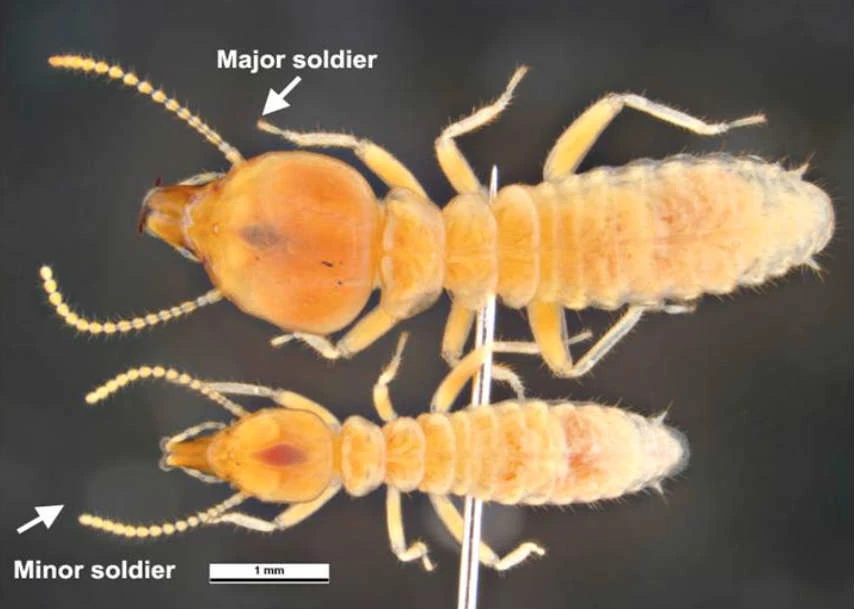For your Home
Login or register for the customer portal
Termites are very small and similar in size to ants, which often leads to confusion. Owing to their secretive nature, they can be hard to detect, especially with an untrained eye. You are far more likely to spot the signs of termite damage before you spot termites themselves.
There are also several different types of termites, which can make figuring out which control method to use challenging. Particularly for termites, correct identification ensures the use of the most effective termite control methods and allows you to choose the most appropriate prevention steps to try and avoid problems in the future.
Need help identifying termites? Call Ehrlich today at 800-837-5520 for advice and to schedule a FREE termite inspection of your home or business.
All types of termites can cause damage to your home, but knowing a bit more about the different species of termites can help identify them more easily. Depending on where you are in the United States can also determine the types of termites you are seeing. Here are some of the most common termite species found in the United States:
.webp)


%20(1).webp)
.webp)
Termite larvae are very small and white in color. The larvae, or “immatures,” are nurtured by other termites until they've grown into a role in the colony. Their presence indicates that there is an active colony growing.
Termite larvae eventually grow into one of three roles in a colony: reproductives, soldiers, or workers. Through a molting process, the larvae will develop into reproductives, which includes termite queens, soldiers or workers depending on the colony’s needs. They send a pheromone throughout the colony to find out which roles are needed and can actually reverse their molting process if they need to take on a different role.
Often confused for moths or flying ants, flying termites (alates) can commonly be found swarming around window sills or exterior lighting because they are attracted to light. The presence of these insects indoors signifies that a building is likely infested. Eventually, these insects will turn into the queens and kings of new colonies.
Alates are the winged reproductives that swarm out from the nest, mate, and establish new colonies.
The workers make up the largest number within a colony. They do most of the work (other than defend and reproduce), consequently causing the destruction that affects so many homes.
Workers are responsible for feeding and grooming other members of the colony. They also excavate the nest and make tunnels.
Soldiers are the next biggest caste within a colony. They have enlarged heads and jaws, and are equipped with sticky fluids or chemical spray for defense.
Soldiers defend the colony against attacks by predatory enemies such as ants.
Starting out life as an alate, she leaves her parents' colony, sheds her wings, and seeks out an environment to nest.
The termite queen looks like a small termite body with a large egg producing chamber. Her skin elongates and becomes translucent, revealing the churning liquid and eggs beneath the skin.
The distended egg chamber makes it impossible for the termite queen to move so the entire termite nest is built around her. The queen provides nutrients for her offspring, and the workers take care of the eggs.
The function of the queen is to reproduce, and she can lay up to 30,000 eggs per day. If not exterminated, a queen can live up to 15 years, producing around 165 million eggs in her lifetime.
Termite eggs are tiny but are visible to the naked eye – appearing as a pile of white powder. However, they are often hidden within termite mud tubes or wooden galleries and are not very easy to find without professional training. Termite eggs are commonly white or light brown in color and translucent.
Termite swarmers are often confused with flying ants. The difference between these two pests will greatly impact the type of service needed to control them in your property. Often a suspected problem with termites, turns out to be a problem with carpenter ants or fire ants, because they look so similar.
Here’s how to establish the general differences in appearance and behavior between ants and termites:
In some cases, it may be possible to identify termites by the damage they cause.
Subterranean termites begin their feeding process from the ground up and typically enter a building through the sub-structure. Homes with crawl spaces are at great risk. It is here you should look for evidence of damaged wood and mud tubes. Wood damaged by this particular species develops “galleries” (hollow tunnels), which run along the grain of the wood.
Drywood termites typically enter structures near the roof line or other exposed wood to begin building a colony. Inspect your attic for evidence of damaged wood. Look for tiny holes in the wood with evidence of frass collecting nearby. Probing the wood can also expose galleries as well.
For more certain identification, your Ehrlich Technician can confirm the invading termite species by visually inspecting the termites themselves. Call us today at 800-837-5520 or contact us online to arrange a FREE termite inspection for your home or business.
Protection from 36 pests and peace of mind with preventative maintenance from PestFree365+. Learn more.